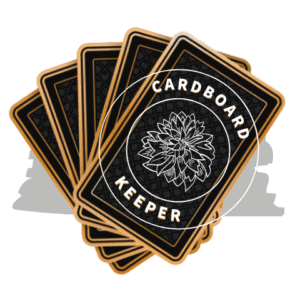After collecting cards from some of the biggest TCGs for over 20 years, the value of some of the rarest cards you can collect never ceases to amaze me.
YuGiOh! is by no means the most expensive collectible card game out there, despite that, with some of the rare cards featured on this list, you might be surprised at the kind of price tags these kinds of cards can command.
If you have a childhood collection of YuGiOh cards still sitting somewhere in a back closet somewhere, you may want to pay close attention to this list of most expensive YuGiOh! cards.
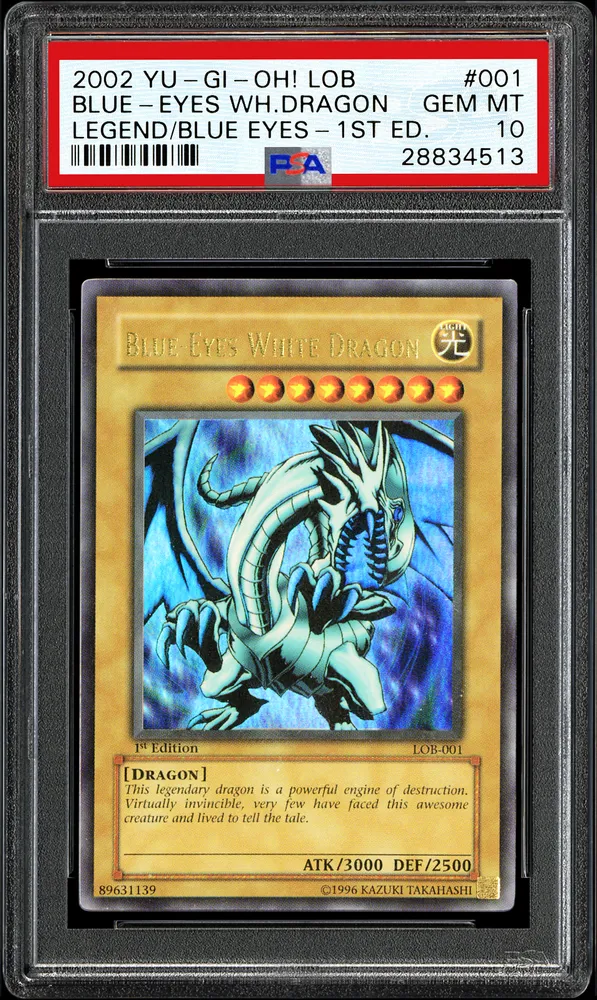
1. Blue-Eyes White Dragon (LOB-001, 2002)
If you asked anyone which Yu-Gi-Oh! card stands out the most, there’s a high chance people would answer it’s the Blue-Eyes White Dragon.
t’s Seto Kaiba’s signature card and has always had a distinctive presence in Yu-Gi-Oh! manga, anime, and games. It’s also the face of the first-ever TCG set, the Legend of Blue Eyes White Dragon, launched in 2002.
The Legend of Blue Eyes White Dragon booster set holds some of the rarest and most expensive Yu-Gi-Oh! cards ever. One unopened booster pack containing 9 random cards has sold for as high as $999 in 2022.
If luck permits, that pack might just have one of the rarest 1st edition TCG cards on this list. And among all of the set’s chase cards, the 1st edition Blue-Eyes White Dragon soars above all with a recorded whopping sale worth $85,000 for a PSA 10, perfect mint card.
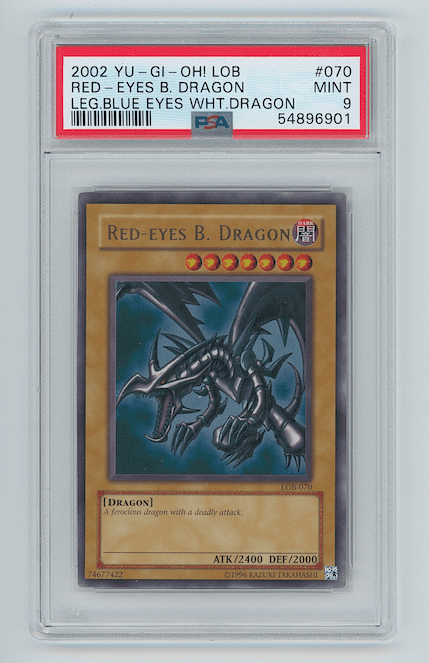
2. Red-Eyes Black Dragon (LOB-070, 2002)
Blue-Eyes White Dragon is undeniably iconic, but there’s also one other dragon that’s immensely popular among fans — the Red-Eyes Black Dragon.
It first appeared in the TCG scene alongside Blue-Eyes as one of the Ultra Rare cards in the 2002 Legend of Blue Eyes White Dragon set.
As the most memorable OG dragons in Yu-Gi-Oh!, comparison between the two becomes inevitable. Red-Eyes seems like the younger kid in the family who can never live up to their older sibling’s grandeur.
Still, there’s no doubt Red-Eyes is still a treasured card among collectors. A PSA 10-graded 1st edition Red-Eyes Black Dragon has been sold for as high as $16,187. Not bad, kid.
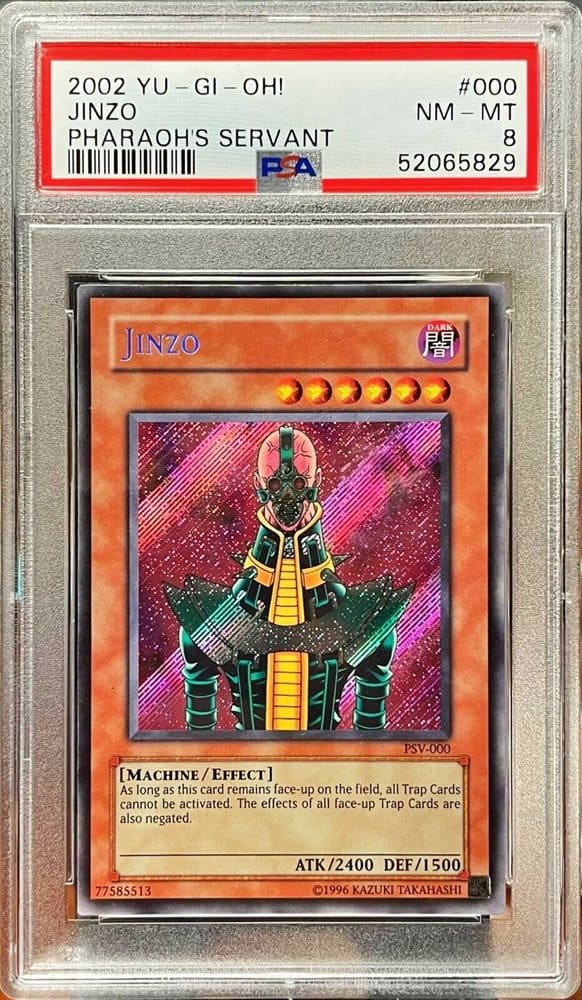
3. Jinzo (PSV-000, 2002)
“You just activated my trap card!” is a Yu-Gi-Oh! catchphrase that has been immortalized as a meme.
The term roughly means that someone’s up for a surprise major beatdown. Certainly, trap cards are terrifying counters that foreshadow unknown consequences as they lie ominously face down on the field.
But you have nothing to fear if you have Jinzo!
Jinzo is a monster with a powerful offense, but its ability to negate the effects of trap cards is what makes it truly special. Jinzo first appeared as a Secret Rare in the TCG booster, Pharaoh’s Servant, in 2002. A PSA perfectly graded card from this 1st edition release can go for as high as $9,200.
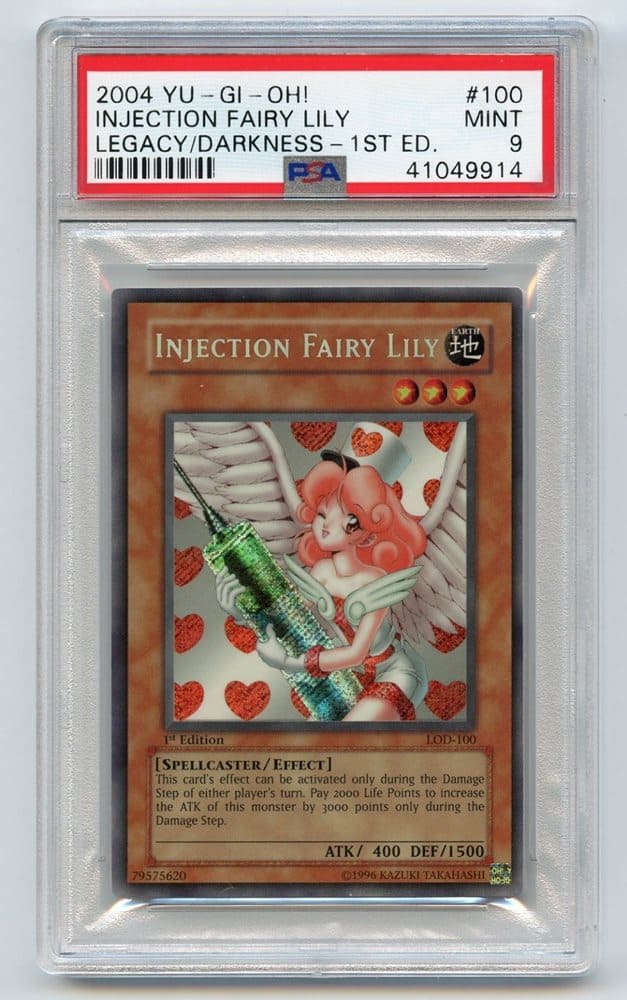
4. Injection Fairy Lily (LOD-100, 2003)
That’s not the injection syringe she’s holding; you may better think of it as a cannon!
Behind her pretty face and sweet smile, Injection Fairy Lily hides a colossal attack. By sacrificing some Life points, you can increase Injection Fairy Lily’s attack by a massive 3000 points.
The card was first released worldwide in the Legacy of Darkness booster in 2003. It was one of two Secret Rares in the pack; the other was Yata-Garasu (code: LOD-000).
Interestingly, a 1st edition PSA 10 Injection Fairy Lily peaked at $5,707 sale, which was a lot higher than Yata-Garasu’s recorded highest at $3,750. The wide price gap may be due to a low number of authenticated gem mints of Injection Fairy Lily with a population of 38, or around 8% of total PSA submissions.
Either that or collectors simply find Lily-chan way cuter than a crow.

5. Exodia, The Forbidden One (LOB-124, 2002)
Exodia’s epic complete form was first introduced in the anime and manga when Yugi draws Exodia’s final part just in time before he gets obliterated by Kaiba’s three Blue-Eyes White Dragons.
It was a defining moment since it was the first time, in-universe, that Exodia’s final form was unleashed. We may not be Yami Yugi’s, but today it’s viable to get Exodia instant wins by strategic deck builds that maximize the ability to draw and shuffle cards.
All Exodia’s five parts first appeared in 2002’s Legend of Blue Eyes White Dragon set as Ultra Rares. PSA 10-graded Exodia cards from this first edition range from around $5,000 to $10,000.
However, the main body named Exodia The Forbidden One (code: LOB-124), eclipses all the other parts’ individual prices with a recorded high worth $35,000.
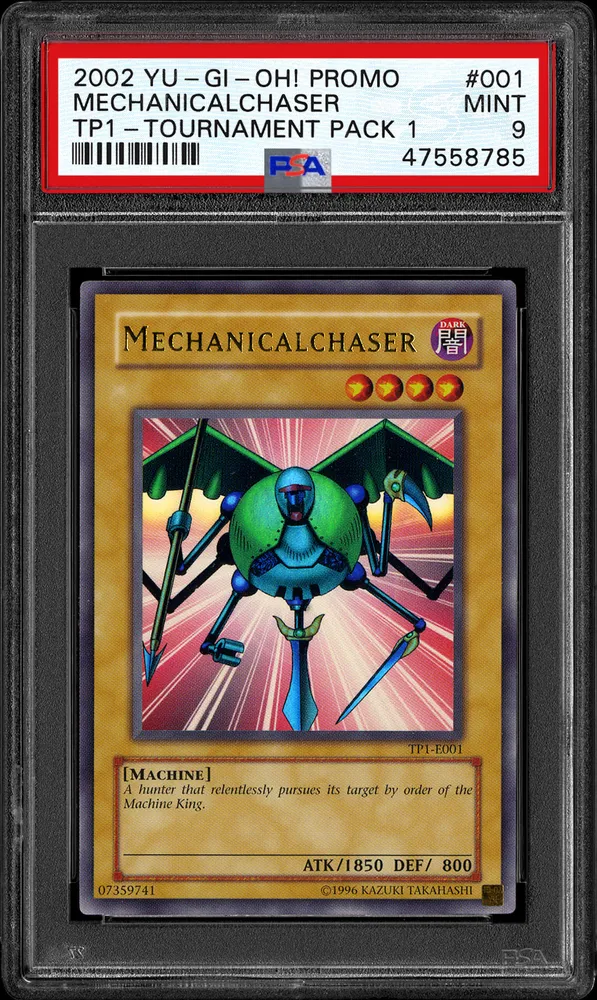
6. Mechanicalchaser (TP1-001, 2002)
Tournament packs are extra-exclusive TCG sets that are only granted to players in sanctioned tournaments at select locations.
It’s hard enough to obtain a pack, as only one is given per entry, but acquiring the best card from the set is even more difficult due to an unusually low 1:108 ratio.
The first TCG Tournament Pack released in September 2002 had Mechanicalchaser as its rarest pull. It was a formidable monster in its early years, having the highest attack among monster cards which didn’t require any tribute to summon.
However, Mechanicalchaser has long lost its edge with the emergence of much stronger low-level cards. But its extreme rarity remains highly valued. With a PSA population below 30 for gem mints, Mechanicalchaser’s price reached up to $10,251.
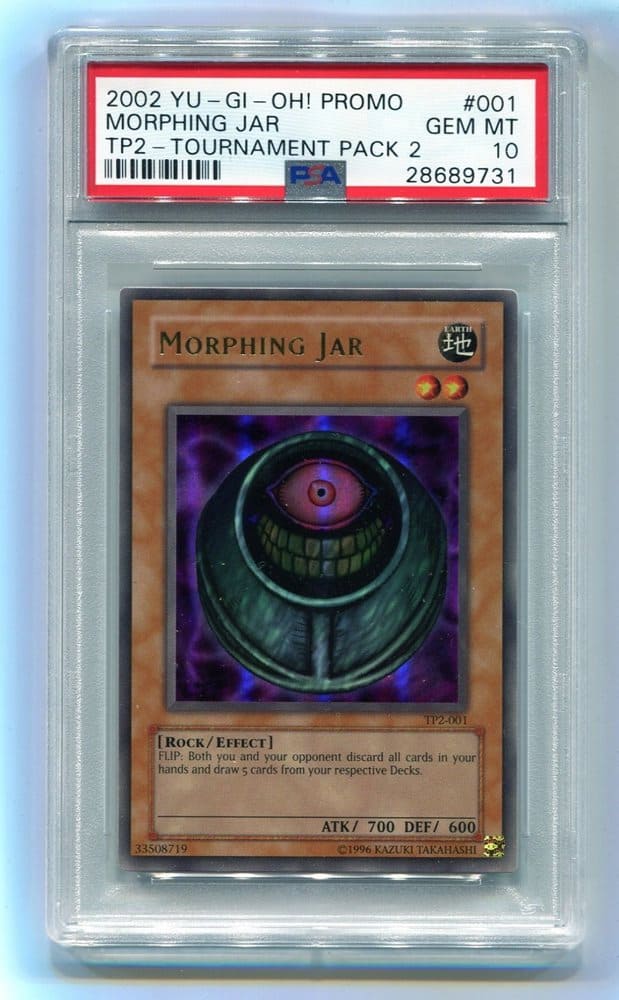
7. Morphing Jar (TP2-001, 2002)
Ultra Rares from Tournament Packs are both rare and expensive, but none more so than Morphing Jar from the Tournament Pack: 2nd Season released in October 2002.
Tournament chase cards like Mechanicalchaser from the 1st Season sell for around $10,000. But a PSA 10 Morphing Jar widely exceeds all the other tournament cards with a sale price worth $54,694.
The card has been re-included in the 4th Season as a Super Rare (code: TP4-002), and though not as expensive as its predecessor, its prices can still go over $3,000 for gem mints.
Tournament edition or not, Morphing Jar had always been valued relatively higher than most for its unique effect. Its discard-and-draw ability lives up to its trickster image, unlocking several cunning and elaborate plays when combined with other key cards. One nefarious strategy, called “Empty Jar“, forces the opponent to draw cards until their deck is exhausted. All done in one turn.
Morphing Jar is a total troll, so it was justifiably ruled that only one copy is allowed in every deck. And it was even forbidden in some duel formats.
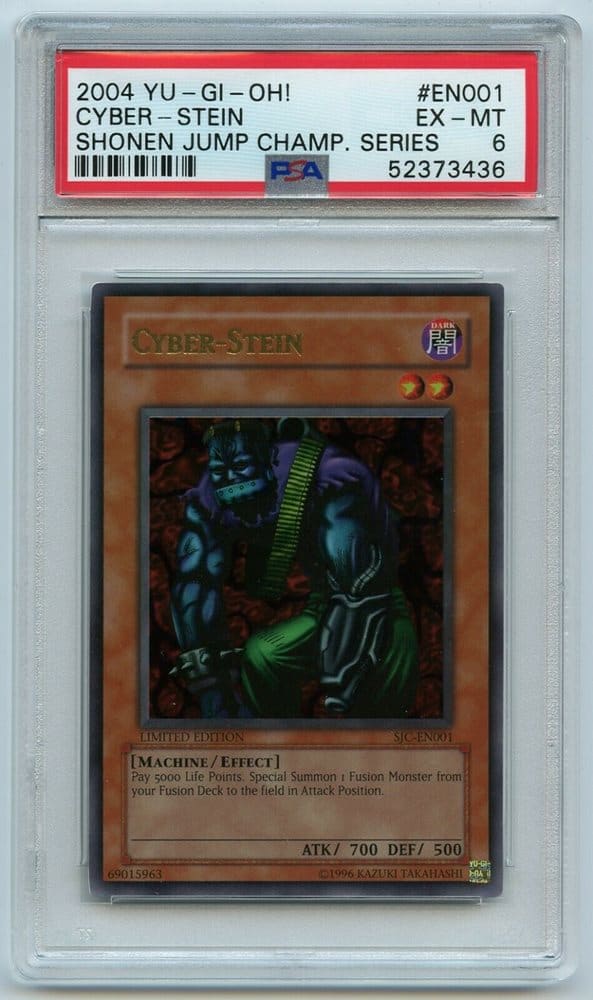
8. Cyber-Stein (SJC-EN001, 2004)
Cyber-Stein goes down in Yu-Gi-Oh! history as the first prize card in a Shonen Jump Championship tournament and the first card to ever get an emergency ban.
The card was made available worldwide in the 2005 Dark Beginnings 2 booster. It quickly became notorious for several one-turn-kill (OTK) plays that used its ability to summon a fusion monster without the required materials. Hence, why it got abruptly banned from tournaments in December 2006.
Cyber-Stein’s first distribution in the 2004 Shonen Jump Championship remains, by far, one of the most expensive Yu-Gi-Oh! cards ever. A PSA 10 card, initially owned by one of the winners at the 2004 SJC event, has been sold for as high as $28,100.
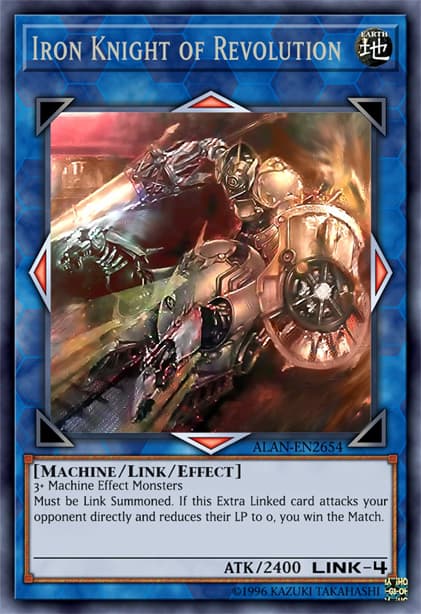
9. Iron Knight of Revolution (2017-EN002, 2017)
At a glance, you may get confused with Iron Knight of Revolution‘s monster effect.
Getting a win when your opponent’s life points drop to zero through a direct attack. Isn’t that how duels usually go? But take a second look and pay attention to the words — “you win the Match“.
A match has, at most, three duels. It is won if a player snatches two duel victories. Monsters like Iron Knight of Revolution, called Match Winners, make it possible to get double duel wins for the price of one.
Match Winners were traditionally the prize cards for the Yu-Gi-Oh! World Championships since 2003. Iron Knight of Revolution was one of two featured prizes in the 2017 World Championships.
And as expected of cards that only world-level winners initially owned, the Iron Knight of Revolution sale price has soared as high as $12,999.

10. Amatsu-Okami of the Divine Peaks (2018-EN002, 2018)
The 2018 World Championship prize card, Amatsu-Okami of the Divine Peaks, drew its design inspiration from Japan’s Amaterasu-Ōmikami mythology.
This was done as a tribute to Japan as the event’s host country. This form of homage has been a recurring theme for World Championships since 2013. Just like how the previous year’s Iron Knight Revolution used Western Europe’s industrial revolution as the inspiration.
Amatsu-Okami of the Divine Peaks, like most championship prize cards, had replicas of lower rarities given to World Championship attendees.
These reprints still hold a decent value, but the original cards previously owned by championship winners are incredibly more expensive. The likes of the 2018 Amatsu-Okami of the Divine Peaks have been reported to have sold for as much as $18,800.
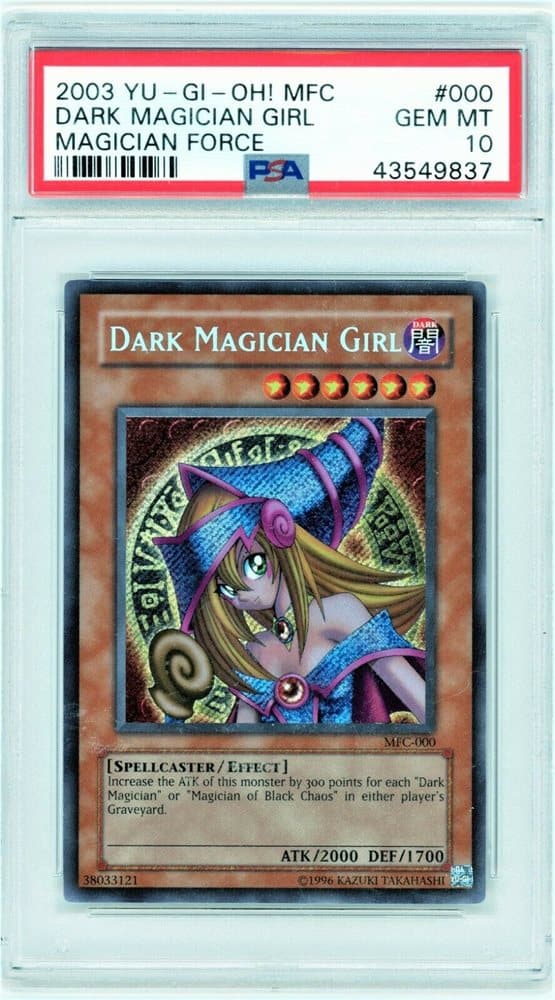
11. Dark Magician Girl (MFC-000, 2003)
Dark Magician Girl is the Yu-Gi-Oh! card that boasts the most artwork versions ever made.
The original card art variations were plenty already, but the count was further blown up by minor alterations due to censorship for western releases.
However, having more of Dark Magician Girl can’t be bad, right? She’s one of the most loved Yu-Gi-Oh! characters whose appeal even reaches beyond fans of the franchise.
Among all its card prints, the priciest ones are the 1st edition OCG and TCG releases. The OCG card was first given away as a prize to winners and runner-ups at Japan’s Duel Monsters III tournament in the year 2000. This version, with card code G3-11, had been sold for around $7,500.
A few years later, the TCG 1st edition Dark Magician Girl (MFC-000) was released worldwide as one of two Secret Rares in the Magician’s Force booster set. The price for a perfect mint for this 2003 TCG edition went much higher at $14,400.
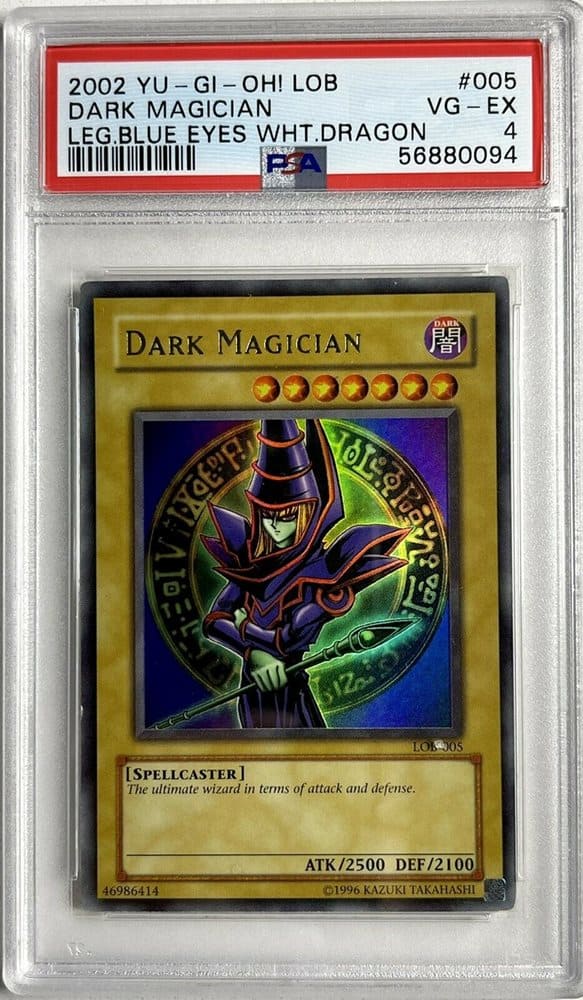
12. Dark Magician (LOB-005, 2002)
If there’s one card that rivals Blue-Eyes White Dragon’s overwhelming popularity, it can only be Yugi’s Dark Magician.
These two monster cards were pitted against each other as the premier Ultra Rares in the first two TCG starter decks released in 2002. The Yugi Starter deck had Dark Magician, while the Kaiba Starter deck had Blue-Eyes.
Weeks before appearing in the starter deck, Dark Magician was included as one of the Ultra Rares in the Legend of Blue Eyes White Dragon booster. Being the first TCG edition, the Legend of Blue Eyes White Dragon set holds many of the most sought-after cards in Yu-Gi-Oh! history.
Dark Magician is among those most treasured cards, which recorded an expensive $16,100 sale for a PSA 10-graded card.
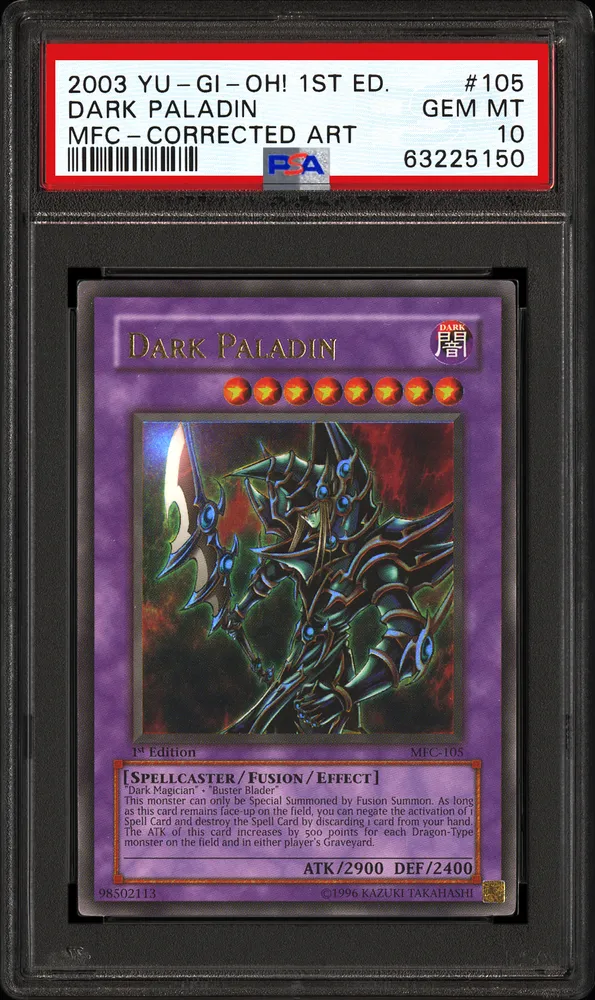
13. Dark Paladin (MFC-105 with corrected art, 2003)
How can a fusion from two epic monsters like Dark Magician and Buster Blader be anything but amazing?
Dark Paladin’s default attack is already powerful, but it also gets boosted for every Dragon monster in the field or graveyard. It is undoubtedly strong, but what really sets it apart is its dark past.
The initial TCG release of Dark Paladin in the 2003 Magician’s Force booster had a minor mishap. The Dark Paladin art meant for the Duel Masters Guide set was incorrectly used in the Magician’s Force version. For the owners to get the corrected version, they had to mail in the misprint and wait for its replacement.
Unfortunately, only a handful of players have undertaken this tedious replacement process. The version with the correct graphic only has a low 64 PSA total population, with only 18 gem mints among them.
This rare 1st edition PSA 10 Dark Paladin with the corrected artwork has been sold for as high as $12,000. While those 1st editions with the errata are not doing terribly either, selling for above $7,000.
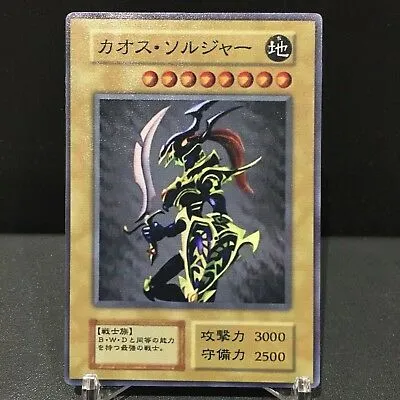
14. Black Luster Soldier (Duel Monsters I Stainless Steel Prize Card, 1999)
February 1999 marks history with the first-ever Yu-Gi-Oh! tournament in the entire world.
The event also became much more special by awarding prize cards made from stainless steel. The person who proposed the idea might have had a severe frustration with keeping their cards mint; hence they wanted it forever-mint in steel. But kidding aside, this golden idea gave birth to Yu-Gi-Oh!’s most expensive card to date.
Each of the top four winners received a steel version of one of these cards: Black Luster Soldier, Super War-Lion, and Fiend’s Mirror.
All four 1999 stainless steel prize cards are one-of-a-kind and would likely go astronomically high on auctions. But the Buster Luster Soldier that was awarded to the tournament champion holds the most prestige and value.
In 2013, it was reported that the 1999 stainless steel Buster Luster Soldier was sold for a mind-blowing $2 million price.
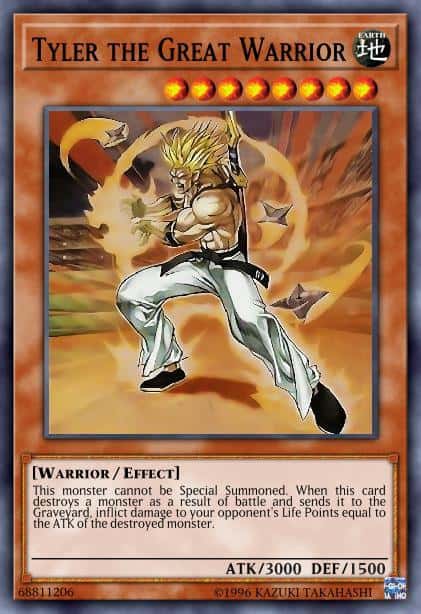
15. Tyler the Great Warrior (TYL-EN001, Make-a-Wish Promo Card, 2005)
The Yu-Gi-Oh! universe is a treasure trove of tales of victory, both in fiction and from real-life players. Out of all of them, there’s probably none as triumphant and heartwarming as the story behind Tyler, the Great Warrior.
In 2005, Make-a-Wish Foundation met Tyler Greese, a 14-year-old boy who was diagnosed with a rare form of liver cancer. The foundation wanted to fulfill one of Tyler’s wishes to give him a happy moment amid difficult circumstances. His wish — to design his very own Yu-Gi-Oh!! card. Thus, the one-of-its-kind Tyler, the Great Warrior card was born.
Tyler Greese had prevailed and had long since fully recovered from the disease. In 2015, he candidly talked about receiving a serious offer of over $75,000 for the card. However, he ultimately decided against selling it.
The Tyler, the Great Warrior card remains in perfect condition and would likely stay with its original owner for many more years to come.
